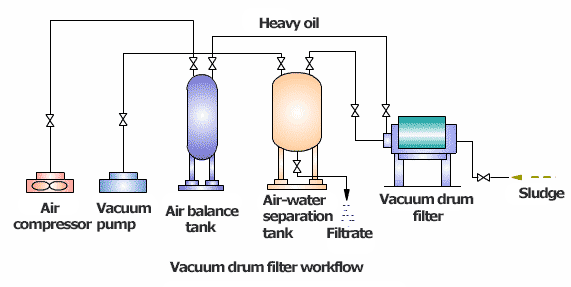The rotary vacuum drum filter achieves continuous solid-liquid separation through the drum's continuous rotation and the action of its internal vacuum system. Its core operational steps include “adsorption-filtration-washing-drying-discharge.”
Core Working Principle
The rotating drum of the vacuum rotary drum filter is submerged in the slurry tank, internally divided into separate sector-shaped filter chambers. Each chamber connects to an external vacuum or compressed air system via a distribution head. When slurry enters the filter chambers, the distribution head activates vacuum suction. Liquid components in the slurry are drawn into the chambers, while solid particles adhere to the filter cloth surface to form a filter cake. As the drum rotates, the filter cake sequentially passes through the washing zone and drying zone. It is then discharged in the unloading zone via compressed air backflushing or scraping by a blade, completing one filtration cycle.

Specific Operating Procedures for Rotary Vacuum Drum Filters:
I. Pre-Startup Preparations
1. First inspect the equipment condition to confirm the filter cloth is undamaged, the drum is free of obstructions, and all connection points are properly sealed.
2. Check whether the pressure in the vacuum system (e.g., vacuum pump, vacuum tank) and compressed air system is normal, ensuring no leaks.
3. Add the slurry to be filtered into the slurry tank and adjust the slurry level to the specified height.
II. Startup and Operational Control
1. Start the vacuum pump first. Once the system vacuum reaches the set value (typically 0.05–0.08 MPa), activate the drum drive motor and adjust the drum speed (usually 0.5–5 rpm based on filter cake thickness and filtration requirements).
2. Activate the wash liquid pump to spray wash liquid into the washing zone. Control the wash liquid flow rate to ensure thorough cake washing.
3. Monitor the filter cake thickness. Maintain it within the optimal range of 5–30 mm by adjusting the slurry concentration, drum rotation speed, or vacuum level.
III. Discharge and Subsequent Processing
1. When the filter cake rotates with the drum into the discharge zone, the distribution head automatically switches to compressed air. Backflushing dislodges the cake from the filter cloth, after which a scraper conveys it to the collection device.
2. The filtered liquid enters the vacuum tank, where it is separated before discharge or recovery. The solid filter cake undergoes subsequent processing as required (e.g., drying, packaging).
IV. Shutdown Procedure
1. First close the slurry feed valve and wash liquid pump, while continuing to run the drum and vacuum pump to complete filtration of the remaining slurry in the tank.
2. Once no filter cake remains on the drum, shut off the vacuum pump, then turn off the drum drive motor.
3. Finally, close the compressed air system. Clean residual material from the slurry tank, filter cloth, and scraper blades. Wash the filter cloth as needed to restore filtration performance.
Operating Precautions:
1. Control vacuum level: Insufficient vacuum slows cake formation and increases filtrate residue; excessive vacuum may clog filter cloth. Adjust according to slurry characteristics.
2. Filter Cloth Maintenance: Regularly inspect filter cloth wear and promptly replace damaged cloth. Clean the filter cloth after each shutdown to prevent solid particles from clogging the pores.
3. Monitor Drum Speed: Excessively high speed may result in an overly thin filter cake, affecting output. Excessively low speed prolongs the filtration cycle and reduces efficiency. Speed must be matched to the slurry filtration rate.
Summary:
In summary, the operation of the rotary vacuum drum filter revolves around four key phases: preparation, operation, discharge, and shutdown. During daily use, routine inspections and maintenance must be performed to ensure optimal solid-liquid separation efficiency and extend the equipment's service life.







